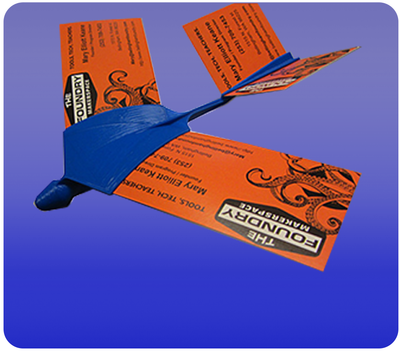AVEX promotes 360-degree entrepreneurial experiences (hence, AVEX360.com). By facilitating projects that touch on design, fabrication, marketing, advertising, accounting and sales, members and guests can discover avenues of interest to explore further.
The following course and workshop descriptions show that you don’t need to master any software to start earning money during Automation Resistance Training.
The following course and workshop descriptions show that you don’t need to master any software to start earning money during Automation Resistance Training.
All classes are 90 minutes long and cost $45 per session.
C2C 101: Introduction to Digital Fabrication
Choose from the variety of product designs shown here, customize your selection and actually make it—all within one 90-minute session!
Choose from the variety of product designs shown here, customize your selection and actually make it—all within one 90-minute session!
You will take away an understanding of how products, ranging from toys to complex robots, can be commercialized with little to no money up front for tooling or large production runs.
We will also show you how to register for a free one-year, renewable license to use Autodesk’s amazing Fusion 360 3D design and fabrication software.
We will also show you how to register for a free one-year, renewable license to use Autodesk’s amazing Fusion 360 3D design and fabrication software.
C2C 102: Find a Need, Fill a Need
At some point, nearly everyone comes up with an invention or way to improve an existing product or service. Find a Need, Fill a Need presents important factors that all prospective entrepreneurs should consider before embarking on the journey to launch a product. The cost of materials, time commitment for design work and any need for experimentation are among the topics discussed. Patents, copyrights and trademarks are compared and contrasted to open source initiatives in light of ever-shortening product life cycles taking place in consumer products.
Two case studies in product development, one an interactive robotic toy and one a machine used in medical manufacturing, are presented to illustrate diverse circumstances one can expect to encounter during the process of innovation and commercialization. Whether a product is simple or complex, this class makes clear that today's digital design and fabrication tools make it possible for individuals to compete with corporations in the consumer, commercial and industrial product spaces.
At some point, nearly everyone comes up with an invention or way to improve an existing product or service. Find a Need, Fill a Need presents important factors that all prospective entrepreneurs should consider before embarking on the journey to launch a product. The cost of materials, time commitment for design work and any need for experimentation are among the topics discussed. Patents, copyrights and trademarks are compared and contrasted to open source initiatives in light of ever-shortening product life cycles taking place in consumer products.
Two case studies in product development, one an interactive robotic toy and one a machine used in medical manufacturing, are presented to illustrate diverse circumstances one can expect to encounter during the process of innovation and commercialization. Whether a product is simple or complex, this class makes clear that today's digital design and fabrication tools make it possible for individuals to compete with corporations in the consumer, commercial and industrial product spaces.
C2C 103: Breaking the Mold
Whereas 3D printing is used today mostly for making prototypes, Breaking the Mold shows how computer-controlled processes can be used not only for development, but for production of end-use products as well. This class delves into design basics, such as using the best process to achieve the "net" or close-to-final shape of a part, the need for establishing tolerances, or fit, between moving parts and the benefit of snap-fits for assembly.
Breaking the Mold is about removing barriers to entry in bringing products to market; the cost of injection molds being one of the most notorious examples. By understanding how digital fabrication differs from conventional manufacturing, participants become better equipped to conceive of new products and new functionality that would otherwise be cost prohibitive. Those who have taken C2C 101 and 102 should, at the conclusion of this class, recognize that the democratization of manufacturing has not only begun, but is accessible to just about everyone.
Whereas 3D printing is used today mostly for making prototypes, Breaking the Mold shows how computer-controlled processes can be used not only for development, but for production of end-use products as well. This class delves into design basics, such as using the best process to achieve the "net" or close-to-final shape of a part, the need for establishing tolerances, or fit, between moving parts and the benefit of snap-fits for assembly.
Breaking the Mold is about removing barriers to entry in bringing products to market; the cost of injection molds being one of the most notorious examples. By understanding how digital fabrication differs from conventional manufacturing, participants become better equipped to conceive of new products and new functionality that would otherwise be cost prohibitive. Those who have taken C2C 101 and 102 should, at the conclusion of this class, recognize that the democratization of manufacturing has not only begun, but is accessible to just about everyone.
C2C 104: Bricks & Clicks
Rounding out the C2C series, Bricks & Clicks demonstrates how to establish final pricing for a product in context to the all-important ROI (return-on-investment). This class showcases the combined power of Fusion 360 and Photoshop for repurposing digital design data for use in high impact marketing and advertising materials. Finally, participants will learn how to build and maintain a free website with zero need for coding (this website being one such example).
Rounding out the C2C series, Bricks & Clicks demonstrates how to establish final pricing for a product in context to the all-important ROI (return-on-investment). This class showcases the combined power of Fusion 360 and Photoshop for repurposing digital design data for use in high impact marketing and advertising materials. Finally, participants will learn how to build and maintain a free website with zero need for coding (this website being one such example).






